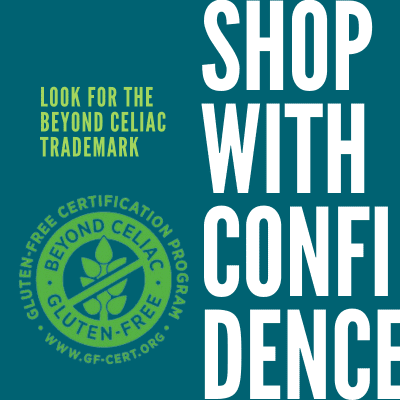Maltodextrin and Allergen Labeling Requirements
May 31, 2011
Question:
I know that malt contains gluten. Is maltodextrin (found in chips, breads) safe for people with celiac disease?
From,
Kate
Answer:
Hi Kate,
The ingredient “maltodextrin” in FDA-regulated food is considered gluten-free if the ingredient list and/or the “Contains” statement do not include the word “wheat.” Please note that maltodextrin is generally considered gluten-free even when derived from wheat, due to how it is processed.
Please read below for more information on gluten-free food labeling and the important distinction between FDA and USDA-regulated foods.
Understanding U.S. Label Reading in Celiac Disease
If a product is labeled “gluten-free,” it has been determined that it is gluten-free by the manufacturer or a certifying body. If a product is not labeled “gluten-free,” please use these guidelines to help you shop safely:
FDA Regulated Foods – Allergen Labeling
FALCPA (Food Allergen Labeling and Consumer Protection Act, Aug 2004): A law requiring FDA-regulated packaged foods to clearly state on the label when a food or an ingredient in a food is or contains protein from one of the 8 major allergens (milk, egg, peanuts, tree nuts, fish, shellfish, soy, and WHEAT).
So, if an ingredient in an FDA-regulated food contains protein from wheat, the word “wheat” must be included on the food label either in the ingredient list or “Contains” statement.
The FDA does not mandate allergen labeling for oats, rye, barley, malt and brewer’s yeast. These ingredients must also be avoided by those with celiac disease. Read below for specific information on oats and the gluten-free diet.
Under this FDA regulation, “food” also includes medical foods, dietary supplements and infant formula. Many dietary supplements voluntarily label their products “gluten-free” or “free of gluten.” If not, check the label carefully for gluten-containing ingredients or contact the manufacturer. Note that the “term ‘food’ does NOT include any medications, either prescription or over-the-counter drugs. The gluten-free status of medications has to be verified.1”
“Under the proposed FDA rule, labeling foods with the term ‘gluten-free’ continues to be voluntary. Foods labeled gluten-free must contain less than 20 parts per million of gluten. A food labeled gluten-free may contain wheat starch if the food contains less than 20 parts per million of gluten. Food containing wheat starch that is not labeled gluten-free should not be eaten. Oats and products containing oats may be labeled gluten-free if they contain less than 20 parts per million of gluten. Oats and products containing oats should not be eaten unless they are labeled gluten-free.1”
A few ingredients to keep in mind:
“Brown rice syrup may be processed with some form of barley, such as barley enzymes, but it is unclear whether these enzymes sometimes contain residual barley gluten2” and, thus, whether it is actually an issue for those with celiac disease. Choose to avoid or include this ingredient in your diet at your own discretion.
“Some dry smoke flavoring may use malted barley flour as a carrier for the smoke. If this ingredient is used in an FDA-regulated food, component ingredients (called subingredients of an ingredient) may or may not be included2.” Check with the manufacturer to determine if malted barley flour was used in the processing.
BOTTOM LINE FOR FDA FOODS : Look for and avoid these words: wheat, rye, barley, oats (unless gluten-free), malt and brewer’s yeast. These words will appear in the ingredients list or the “Contains” statement (or both). Check the subingredients of dry smoke flavoring.
USDA Regulated Foods
The Food Safety and Inspection Service (FSIS) of the USDA (United States Department of Agriculture) regulates meat, poultry and egg products.
Examples are:
- Processed meat products (examples: hot dogs, deli meat, processed sausage)
- Processed poultry products (example: seasoned chicken breast)
- Processed egg products (examples: dried, frozen, or liquid eggs with or without added ingredients)
- Processed mixed food products that generally contain more than 3 percent raw meat or 2 percent or more cooked meat or poultry meat (examples: some soups)
The FALCPA did not amend the acts which regulate meat, poultry and egg products; therefore, allergen labeling of USDA-regulated foods is voluntary. When you are shopping, look to see if the label you are reading has any FALCPA-like allergen labeling statements visible (i.e. “Contains” statement or allergens declared in the ingredients list). If there is nothing on the label to indicate that the manufacturer is voluntarily complying with the FDA allergen labeling guidelines, then use the information below to help you read the label for possible gluten and contact the manufacturer to clarify the source of ingredients.
Instead of the allergen law, the USDA declares that all ingredients must be listed in the ingredient list by their “common or usual name.” Examples of this include modified food starch and dextrin, maltodextrin, caramel and glucose. These names, however, do not always indicate the source of the ingredient, such as wheat. Please note that maltodextrin, caramel and glucose syrup are generally considered gluten-free even when derived from wheat, due to the processing.
In USDA products, look for the following words:
- Modified food starch
- Starch
- Dextrin
These ingredients may be derived from wheat but not necessarily be listed as containing wheat. If the source of the ingredient is not listed, contact the manufacturer to determine its source. Avoid it if the source is wheat.
Also, look for and avoid the words: durum flour, enriched flour, farina, graham flour, plain flour, self-rising flour, bulgur, spelt, triticale, semolina, and white flour—these are all words that mean “wheat.”
Look for the words brown rice syrup. “Brown rice syrup may be processed with some form of barley, such as barley enzymes, but it is unclear whether these enzymes sometimes contain residual barley gluten3” and, thus, whether it is actually an issue for those with celiac disease. It is also unlikely that brown rice syrup would appear in a USDA labeled product. Choose to avoid or include this ingredient in your diet at your own discretion.
Look for the words smoke flavoring. “Some dry smoke flavoring may use malted barley flour as a carrier for the smoke. If this ingredient is in a meat or poultry product (regulated by the USDA), any barley ingredient used in the smoke flavoring will be listed in the ingredient’s list by its common or usual name3” [i.e. malt].
BOTTOM LINE FOR USDA PRODUCTS: Avoid these words: wheat, rye, barley, oats (unless gluten-free), malt, brewer’s yeast, modified food starch (unless the source is gluten-free), dextrin (unless the source is gluten-free), and all the words meaning “wheat” in the above paragraph.
Fortunately, 80–90% of USDA regulated products are voluntarily labeling foods for allergens3, including labeling the product “gluten-free” on the package. And among the 10-20% of foods that are not voluntarily labeling foods for allergens, the number of foods containing ingredients actually derived from wheat is likely small.
The American Dietetic Association (ADA) recently released practice guidelines on labeling education and the movement is towards educating on the differences in labeling laws between the FDA and USDA.
Sincerely,
Melinda Dennis, MS, RD, LDN
Nutrition Coordinator, Celiac Center at BIDMC
References:
1.Recommendations Summary. Provide Resources and Education on Label Reading. Evidence Analysis Library. American Dietetic Association. http://www.adaevidencelibrary.com/template.cfm?template=guide_summary&key=2376. Accessed October 21, 2010.
2. Thompson, T, Case, S. Food Labeling in the United States and Canada. In Real Life with Celiac Disease. Dennis, M, Leffler D, eds. AGA Press, Bethesda, MD, 2010.
3.Labeling of USDA-Regulated Foods. Available at http://www.glutenfreedietitian.com/articles/BLOGUSDALabelingBlog.30.pdf. Accessed October 21, 2010.
Additional Reading:
- Food and Drug Administration. Food Allergen Labeling and Consumer Protection Act of 2004. Available at https://www.fda.gov/food/food-allergensgluten-free-guidance-documents-regulatory-information/food-allergen-labeling-and-consumer-protection-act-2004-falcpa
- Food and Drug Administration. Final Rule on Food Labeling: Gluten-Free Labeling of Foods. Available at https://www.federalregister.gov/documents/2013/08/05/2013-18813/food-labeling-gluten-free-labeling-of-foods
- United States Department of Agriculture. A Guide to Federal Food Labeling Requirements for Meat and Poultry Products. Available at https://www.fsis.usda.gov/sites/default/files/import/Labeling_Requirements_Guide.pdf and www.glutenfreedrugs.com.
- National Institutes of Health Consensus Development Conference on Celiac Disease. Consensus Development Conference Statement. Available at http://consensus.nih.gov/2004/2004CeliacDisease118html.htm.


